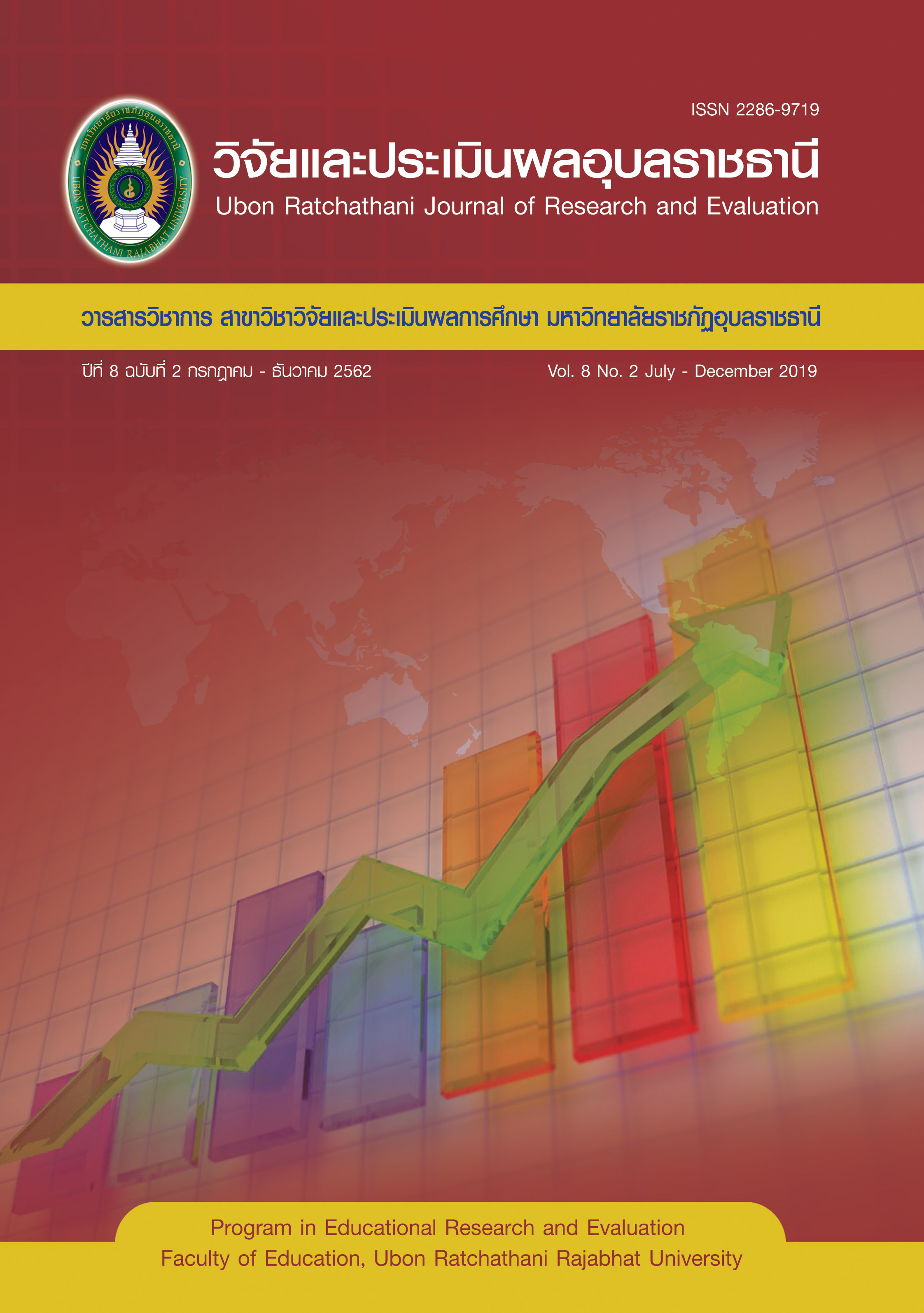The Development of Creative Thinking for Early Childhood Students by Using MATH-3C Learning Management at Nawaprachason School under the Mukdahan Primary Educational Service Area Office
Keywords:
Creative Thinking, Learning Management by using the MATH-3C, Research Operation, Early ChildhoodAbstract
Abstract
The purposes of this research were to (1) operate development of creative thinking for early childhood students by using the MATH-3C learning management and (2) compare the creative thinking of the early childhood students before and after using the MATH-3C learning management. The target group, consisted of 21 students, studying in the second year of the kindergarten at Nawaprachasan School under the Mukdahan Primary Educational Service Area Office. The research model was created by the research techniques based on Lewin’s concepts. The research instruments were 1) the experience management plan by using the MATH-3C learning management, 2) the creative thinking test, 3) the post-experience record form, and 4) the interview form. The statistics were percentage, mean, standard deviation, and percentage of development score.
The research findings were as follows:
- The MATH-3C learning management was operated to develop creative thinking by applying action research model based on the Lewin’s concepts. It consisted of 4 steps: 1) stimulating the thirst of knowledge, 2) decision-making to choose activities, 3) playing activities, and 4) presenting the outcomes.
- The comparison of the creative thinking before and after using the MATH-3C learning management indicated that the early childhood had the overall mean of the creative thinking before using the MATH-3C learning management were percentage at 57.34 %, while that of the creative thinking after using the MATH-3C learning management were percentage at 85.58 %. And the percentage of development score was at 66.20%.
References
Amatayakul, K. (1993). Taught to be a genius according to Neo-Humanism (5th ed.). Bangkok:
Pab Pim. [in Thai].
เชวง ซ้อนบุญ. (2554). การพัฒนารูปแบบการเรียนการสอนแบบ MATH-3C เพื่อพัฒนาทักษะพื้นฐานทางคณิตศาสตร์ของเด็กปฐมวัย (ปริญญานิพนธ์การศึกษาดุษฎีบัณฑิต สาขาการศึกษาปฐมวัย). มหาวิทยาลัยศรีนครินทรวิโรฒ, กรุงเทพฯ.
Sonboon, C. (2011). The development of MATH-3C instructional model to develop basic mathematical skills of Yong children (Master of education thesis, program in Early Childhood Education). Srinakharinwirot University, Bangkok. [in Thai].
ทิวัตถ์ นกบิน. (2542). การศึกษาความสัมพันธ์ระหว่างความคิดสร้างสรรค์กับผลสัมฤทธิ์ทางการเรียน (ปริญญานิพนธ์การศึกษามหาบัณฑิต สาขาวิชาการวัดผลการศึกษา). มหาวิทยาลัยศรีนครินทรวิโรฒ, กรุงเทพฯ.
Nok Bin, T. (1999). A study of the relationship between creativity and academic achievement (Master of education thesis, program in Measurement). Srinakharinwirot University, Bangkok. [in Thai].
นวพร ทวีวิทย์ชาคริยะ. (2541). ความคิดเชิงเหตุผลของเด็กปฐมวัยที่ได้รับการจัดประสบการณ์แบบปฏิบัติการทดลองกับแบบปกติ (ปริญญานิพนธ์การศึกษามหาบัณฑิต สาขาวิชาการศึกษาปฐมวัย) มหาวิทยาลัย
ศรีนคริทรวิโรฒ, กรุงเทพฯ.
Thawiwitchakriya, N. (1998). Rational thinking of preschool children provided by experiential experience trial and traditional model (Master of education thesis, program in Early Childhood Education). Srinakharinwirot University, Bangkok. [in Thai]
ลำพรรณ์ ใจทัศน์. (2558). การพัฒนาทักษะการคิดพื้นฐานของเด็กปฐมวัยโดยการจัดการเรียนรู้แบบ MATH-3C โรงเรียนนาหว้าประชาสรรค์ อำเภอดอนตาล จังหวัดมุกดาหาร (วิทยานิพนธ์ครุศาสตรมหาบัณฑิต
สาขาการจัดการการปฐมวัยศึกษา) มหาวิทยาลัยราชภัฏพระนคร, กรุงเทพฯ.
Jaithas, L. (2015). Development of preschooler’s basic thinking skills by implementing MATH-3C learning management, NawaPrachasan School, Don Tan District, Mukdahan Province (Master of Education thesis, program in Early Childhood Management). Phranakhon Rajabhat University, Bangkok. [in Thai].
วราภรณ์ รักวิจัย. (2533). การอบรมเลี้ยงดูเด็กปฐมวัย. กรุงเทพฯ: ต้นอ้อแกรมมี่.
Rakwijai, W. (1990). Parenting of young children. Bangkok: Ton Oar, Grammy. [in Thai].
ศรีแพร จันทราภิรมณ์. (2550). ความคิดสร้างสรรค์ของเด็กปฐมวัยที่ได้รับการจัดกิจกรรมศิลปะสร้างสรรค์
โดยเปลือกข้าวโพด (ปริญญานิพนธ์การศึกษามหาบัณฑิต สาขาวิชาการศึกษาปฐมวัย). มหาวิทยาลัย
ศรีนครินทรวิโรฒ, กรุงเทพฯ.
Jantraphirom, S. (2007). Creative thinking of preschool children participated in corn husks art activities (Master of education thesis, program in Early Childhood Education). Srinakharinwirot University, Bangkok. [in Thai].
สำนักงานคณะกรรมการการศึกษาเอกชน. (2531). ชุดฝึกอบรมบุคลากรระดับก่อนประถมศึกษา หน่วยที่ 1 พัฒนาการของเด็กระดับก่อนประถมศึกษา. กรุงเทพฯ: รุ่งศิลป์การพิมพ์.
Office of the Private Education Commission. (1988). Training package for personnel at Pre-primary level, unit 1 development of Pre-primary school children. Bangkok: Roongsin Printing. [in Thai].
สำนักงานคณะกรรมการการศึกษาแห่งชาติ. (2523). เด็กก่อนวัยเรียนกับการเรียนรู้และหลักสำคัญบางประการ. กรุงเทพฯ: เจริญผลการพิมพ์.
Office of the National Education Commission. (1980). Preschool children learning and some important principles. Bangkok: Charoen Phon Printing. [in Thai].
สำนักงานรับรองมาตรฐานและประเมินคุณภาพการศึกษา. (2555). รายงานการประเมินคุณภาพภายนอกรอบสาม (พ.ศ.2554-2558) ระดับการศึกษาขั้นพื้นฐาน. กรุงเทพฯ: ผู้แต่ง.
Office for National Education Standards and Quality Assurance. (2012). The third round of external quality assessment reports (2011-2015) basic education level. Bangkok: Author. [in Thai].
Posakrisana, A. (1989). Measurement of Thai children creativity using the TCT-DP drawing test (Master of education thesis, program in Educational Administration and Higher Education). University of Southern Illinois at Carbondale, USA.
Downloads
Published
How to Cite
Issue
Section
License
1. บทความที่ตีพิมพ์ในวารสารนี้ได้มีการตรวจสอบการลอกเลียนงานวรรณกรรมแล้ว ไม่เกินร้อยละ 25
2. บทความที่ตีพิมพ์ในวารสารนี้เป็นข้อคิดเห็น ข้อค้นพบของผู้เขียนบทความ โดยผู้เขียนบทความต้องเป็นผู้รับผิดชอบต่อผลทางกฎหมายใด ๆ ที่อาจเกิดขึ้นจากบทความนั้น ๆ
3. บทความ ข้อมูล เนื้อหา รูปภาพ ฯลฯ ที่ได้รับการตีพิมพ์ในวารสารวิจัยและประเมินผลอุบลราชธานี ถือเป็นลิขสิทธิ์ของวารสารวิจัยและประเมินผลอุบลราชธานี หากบุคคลหรือหน่วยงานใดต้องการนำทั้งหมดไปเผยแพร่ต่อหรือเพื่อกระทำการใดๆ จะต้องได้รับอนุญาตเป็นลายลักษณ์อักษรจากวารสารวิจัยและประเมินผลอุบลราชธานีก่อนเท่านั้น และจะต้องมีการอ้างอิงวารสารวิจัยและประเมินผลอุบลราชธานี ฉบับนั้น ๆ ด้วย






